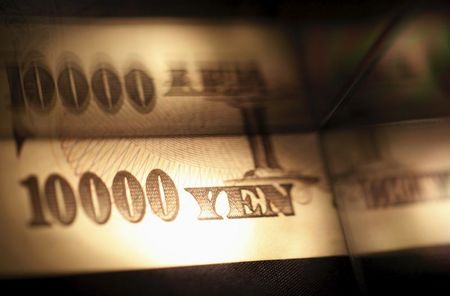Forex
Asia FX muted as dollar dips on recession fears; yen surges to near 7-mth high

Investing.com– Most Asian currencies moved in a tight range on Monday, taking little advantage of a softer dollar amid growing concerns over a slowdown in U.S. economic growth.
The Japanese yen was an outlier, strengthening sharply on safe haven demand and as the prospect of more interest rate hikes by the Bank of Japan underpinned the currency.
Other units such as the Chinese yuan also appreciated sharply, although this was mostly driven by a substantially stronger-than-expected midpoint fix from the central bank.
Sentiment towards regional markets was battered by a persistent sell-off in risk-driven assets, as a string of weak economic readings from the U.S. drove up concerns over slowing growth and largely offset optimism over lower interest rates.
Japanese yen surges on safe haven demand
The Japanese yen was the best performer in Asia on Monday, with the pair dropping 1.4% to 144.53 yen- its weakest level since mid-January.
The yen extended recent gains against the dollar after the Bank of Japan last week hiked interest rates and said it planned to raise rates further this year amid some pick-up in inflation and spending.
The minutes of the BOJ’s June meeting, released earlier on Monday, also presented an unexpectedly hawkish stance for the BOJ.
This was coupled with data that showed a sharp rebound in Japanese service sector activity, which also indicated some resilience in the economy.
Dollar weak amid recession fears, rate cut bets
The and fell 0.3% each in Asian trade and hit their lowest level in 4-½ month lows.
The greenback saw little safe haven demand as worsening economic conditions in the U.S. saw traders begin pricing in the potential for an ever greater raft of interest rate cuts by the Federal Reserve.
Traders are now pricing in a 74% chance the Fed will cut rates by 50 basis points in September, compared to prior bets on a 25 bps cut, showed.
The central bank is expected to bring rates down by a total 100 basis points this year, amid concerns over slowing economic growth. Such a scenario bodes poorly for the dollar, and portends some strength in Asian currencies.
But weak risk appetite saw most Asian units soften on Monday. The Australian dollar’s pair fell 0.2% before a on Tuesday, where the central bank is widely expected to keep rates unchanged following recent data that showed inflation was cooling slightly.
The Chinese yuan’s pair fell 0.3% to a six-month low, with a bulk of the strength coming from a stronger-than-expected midpoint fix by the PBOC. The central bank was also seen intervening in currency markets in July, as a string of weak readings on China’s economy battered the yuan.
But on Monday showed some resilience in the country’s services sector.
South Korean won’s pair rose 0.2%, while the Indian rupee’s pair remained in sight of record highs.

 Forex3 years ago
Forex3 years agoForex Today: the dollar is gaining strength amid gloomy sentiment at the start of the Fed’s week

 Forex3 years ago
Forex3 years agoUnbiased review of Pocket Option broker

 Forex3 years ago
Forex3 years agoDollar to pound sterling exchange rate today: Pound plummeted to its lowest since 1985

 Forex3 years ago
Forex3 years agoHow is the Australian dollar doing today?

 Cryptocurrency3 years ago
Cryptocurrency3 years agoWhat happened in the crypto market – current events today

 World3 years ago
World3 years agoWhy are modern video games an art form?

 Commodities3 years ago
Commodities3 years agoCopper continues to fall in price on expectations of lower demand in China

 Economy3 years ago
Economy3 years agoCrude oil tankers double in price due to EU anti-Russian sanctions





















